Starter/Battery Cable (How Long?)
Discussion
Can someone explain how the hot start kit (which at the end of the day is just a relay) repairs years of pitting on the contact faces of the relay inside the Meta immobiliser unit.
I am struggling to understand the mysterious magical forces at foot here.
Does the hot start kit reverse years on contact face pitting?
Does the hot start kit open up the Meta unit and replace the worn out relay with a new one?
Does it reverse the path of electrons through the worn out Meta immobiliser relay to give it a whole new lease of life?
Could it be a whole new scientific discovery has been found debunking everything known & understood about physics & electrical theory for over 100 years.
If so I'd love to hear about it!
Or could it be the hot start kit just masks the real problem for a while, only for it to return at a later date leaving you stranded in the dark & cold one night wondering why the hot start problem has returned even though you fitted the hot start kit?
I am really struggling to understand just how the application of an addition relay (the hot start kit) can possibly repair the worn out Meta relay that's buried & potted into the immobiliser unit.
I'm sorry, but if the Meta relay is burnt & pitted, which it will be, your only two choices to resolve the problem (which is the real reason for the hot start fault), is to either replace the whole immobiliser unit, or bypass it completely.
There is no relay in the world known to mankind that can repair years of damage on another relay.
It's a scientific and physical impossibility, the damage to the contact faces on the Meta relay has been done, period, its completely irreversible, FACT!
And its simply because that Meta relay was never nan enough for the job, this was also compounded by the fact TVR wired it back to front.
That damage remains no matter if you fit the hot start kit or not, so what also remains is the fault.
If you are not paying attention here the next time you'll discover this will be when you can't start your car at the most inconvenient moment, hot start kit fitted or not!
I am struggling to understand the mysterious magical forces at foot here.
Does the hot start kit reverse years on contact face pitting?
Does the hot start kit open up the Meta unit and replace the worn out relay with a new one?
Does it reverse the path of electrons through the worn out Meta immobiliser relay to give it a whole new lease of life?
Could it be a whole new scientific discovery has been found debunking everything known & understood about physics & electrical theory for over 100 years.
If so I'd love to hear about it!
Or could it be the hot start kit just masks the real problem for a while, only for it to return at a later date leaving you stranded in the dark & cold one night wondering why the hot start problem has returned even though you fitted the hot start kit?
I am really struggling to understand just how the application of an addition relay (the hot start kit) can possibly repair the worn out Meta relay that's buried & potted into the immobiliser unit.
I'm sorry, but if the Meta relay is burnt & pitted, which it will be, your only two choices to resolve the problem (which is the real reason for the hot start fault), is to either replace the whole immobiliser unit, or bypass it completely.
There is no relay in the world known to mankind that can repair years of damage on another relay.
It's a scientific and physical impossibility, the damage to the contact faces on the Meta relay has been done, period, its completely irreversible, FACT!
And its simply because that Meta relay was never nan enough for the job, this was also compounded by the fact TVR wired it back to front.
That damage remains no matter if you fit the hot start kit or not, so what also remains is the fault.
If you are not paying attention here the next time you'll discover this will be when you can't start your car at the most inconvenient moment, hot start kit fitted or not!
Bassfiend229hp said:
So - in summary - we have a number of contributing factors of which, when taken individually and in isolation, none are a definitive cause of a specific problem (in this case generically refferred to as "the hot start issue") they can all contribute to causing this phenomenon.
Therefore, best practice would appear to be to eliminate as many of the contributing factors as possible, no?
That's it, well done, spot on Phil Therefore, best practice would appear to be to eliminate as many of the contributing factors as possible, no?


Your comments are the best & most concise conclusion to all this I've ever seen

All I would add is that the immobiliser is far and away the most likely cause of what is commonly referred to as "The Hot Start Fault".
Carl Baker made a living out of the fact TVR wired the immobiliser incorrectly, he told me as much when I discussed with him at length what I'd found on my car.
If you look way back at discussions on TVR reliability it was also a big problem when the cars were current, now look at the last year of PH & amazingly you'll see a huge number of people are still suffering from the problem.
All the evidence suggests the immobiliser, or more accurately the way TVR wired it, & the fault that creates, represents the largest cause of Chim or Griff no starts by a country mile.
If you really want to make these cars start reliably hot or cold just follow the following 4 steps.
Step 1: Bypass the immobiliser on the starter solenoid circuit or replace the entire alarm system properly
Step 2: Improve the tired old feeble hugely long battery to starter cable with something better
Step 3: Add in an additional earth from the battery neg terminal to the engine block
Step 4: Add a suitable relay to the starter solenoid circuit where TVR neglected to fit one
As long as your battery & starter motor are in good shape you can say goodbye your TVR failure to start issues for good

You will end up with a Chim or Griff that cranks like you never thought possible, You'll also be improving it's reliability by a 1000%.
Finally it seems these cars do seem to suffer parasitic battery drains more than most.
This can be due to many reasons, so each car needs to be assessed in isolation by a competent auto electrician.
I traced my parasitic drain to the alarm, or more specifically the microwave sensor.
This added more weight to the argument for getting the complete alarm system professionally replaced.
However as an interim solution I just added a Battery Brain, which worked so well it a solution I would recommend to anyone with the battery drain problem but who doesn't necessarily have a spare £600 for a new alarm/immobiliser system.
Edited by ChimpOnGas on Sunday 3rd March 16:55
At best TVR's 7ft run of 20mm3 cable could really only be described as marginal when new, however after many years of service internal corrosion is inevitable so the resistance in that starter cable will very likely be sufficient to cause slow cranking or no cranking at all.
Of course you could fit the worlds thickest starter cable and it would give no improvement whatsoever if the earth side of the circuit is not in good order too, study the earth return TVR gave us and you'll discover the following:
1. Another equally thin but admitedly much shorter cable running from the block close to the oil pressure switch to a stud on the O/S outrigger diagonal which is subject to a lot of spray and general road debris that in the UK contains corrosive salts.
2. From this exposed stud the electrons must travel down the corrosion prone steel chassis some 5ft as the crow flies to where yet another thin cable is attached to the N/S body mounting point on the transmission tunnel.
3. This bolt can work loose causing a poor connection, even if it is tight the electrons still have to pass down the last 3ft run of cable before finally reaching the battery negative terminal.
To be honest the earth return part of the high amp starter circuit is as bad if not often worse than the positive side, add them together and throw in a little corrosion and the entire hugely long 15ft loop is subject to enormous resistance so its no wonder Chimaera & Griffiths suffer starting issues.
As part of your starter cable upgrade you really need to complete the job by running a thicker cable from that earth stud on the outrigger to the block (an alternator mounting bolt is a good choice), then run a second thick cable from there directly back to the battery negative terminal. Like this you'll not only enjoy much stronger and reliable starting but you'll likely see othe benefits relating to the other sensors ect that are earthed at the outrigger stud.
Now turn your attentions to the immobiliser, TVR incorrectly wired it so internal immobiliser relay failures are common. Replacement is the best option here and Abacus Alarms offer a plug and play kit thats designed in such a way as to make it impossible for TVR's mistake cannot be repeated. Alternatively and if money is tight the immobiliser can be bypassed in such a way as to still retain a line of defence against theft, if anyone would like to know how to complete this bypass they should PM me for my easy to follow instructions and I will share by return.
Once the immobiliser issue is fixed and both the live/earth elements of the high amp starter circuit are uprated a vehicle that has a reputation for starting issues suddenly becomes the most reliable cranking car ever. As the author of this post I did all this over seven years ago and have never since had a single cranking issue.
But don't just do the starter cable, be sure to upgrade the earth return as described too or you'll only be doing half the job and you'll not get the full benefit, finish off by addressing the immobiliser issue and you'll be doing the best things to improve the reliability of your TVR by far.
Finally forget the hot start kit, it really is an unnecessary collection of wires and a relay that only adds anothe point of potential failure, its designer sold it as a cure all for Chimaera/Griff starting issues when the truth is he failed to understand the real reasons our cars suffer the problem. If you have a hot start kit, I'd rip it out as part of the proper package of improvements as described and you'll never look back.
Of course you could fit the worlds thickest starter cable and it would give no improvement whatsoever if the earth side of the circuit is not in good order too, study the earth return TVR gave us and you'll discover the following:
1. Another equally thin but admitedly much shorter cable running from the block close to the oil pressure switch to a stud on the O/S outrigger diagonal which is subject to a lot of spray and general road debris that in the UK contains corrosive salts.
2. From this exposed stud the electrons must travel down the corrosion prone steel chassis some 5ft as the crow flies to where yet another thin cable is attached to the N/S body mounting point on the transmission tunnel.
3. This bolt can work loose causing a poor connection, even if it is tight the electrons still have to pass down the last 3ft run of cable before finally reaching the battery negative terminal.
To be honest the earth return part of the high amp starter circuit is as bad if not often worse than the positive side, add them together and throw in a little corrosion and the entire hugely long 15ft loop is subject to enormous resistance so its no wonder Chimaera & Griffiths suffer starting issues.
As part of your starter cable upgrade you really need to complete the job by running a thicker cable from that earth stud on the outrigger to the block (an alternator mounting bolt is a good choice), then run a second thick cable from there directly back to the battery negative terminal. Like this you'll not only enjoy much stronger and reliable starting but you'll likely see othe benefits relating to the other sensors ect that are earthed at the outrigger stud.
Now turn your attentions to the immobiliser, TVR incorrectly wired it so internal immobiliser relay failures are common. Replacement is the best option here and Abacus Alarms offer a plug and play kit thats designed in such a way as to make it impossible for TVR's mistake cannot be repeated. Alternatively and if money is tight the immobiliser can be bypassed in such a way as to still retain a line of defence against theft, if anyone would like to know how to complete this bypass they should PM me for my easy to follow instructions and I will share by return.
Once the immobiliser issue is fixed and both the live/earth elements of the high amp starter circuit are uprated a vehicle that has a reputation for starting issues suddenly becomes the most reliable cranking car ever. As the author of this post I did all this over seven years ago and have never since had a single cranking issue.
But don't just do the starter cable, be sure to upgrade the earth return as described too or you'll only be doing half the job and you'll not get the full benefit, finish off by addressing the immobiliser issue and you'll be doing the best things to improve the reliability of your TVR by far.
Finally forget the hot start kit, it really is an unnecessary collection of wires and a relay that only adds anothe point of potential failure, its designer sold it as a cure all for Chimaera/Griff starting issues when the truth is he failed to understand the real reasons our cars suffer the problem. If you have a hot start kit, I'd rip it out as part of the proper package of improvements as described and you'll never look back.
FoxTVR430 said:
I agree Dave.
I should have included a better photo showing the return (negative) cable.
I have made a 50mm² -ve cable to go from the starter motor directly to the battery. (it is a tight fit through the bulk head).
Then from the alternator to the chassis bolt as you described above.
The OLD situation.
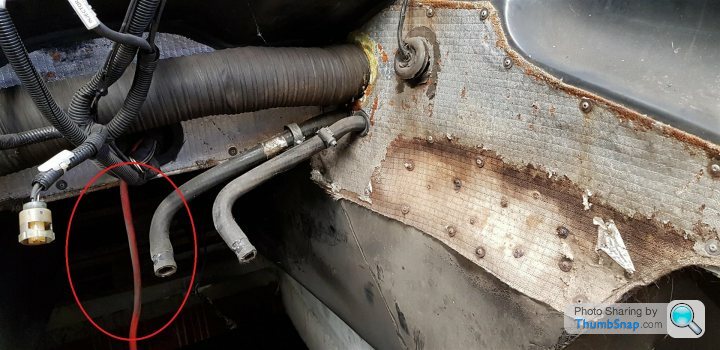
As it is now. not the best photo, but this is all I have at the moment.
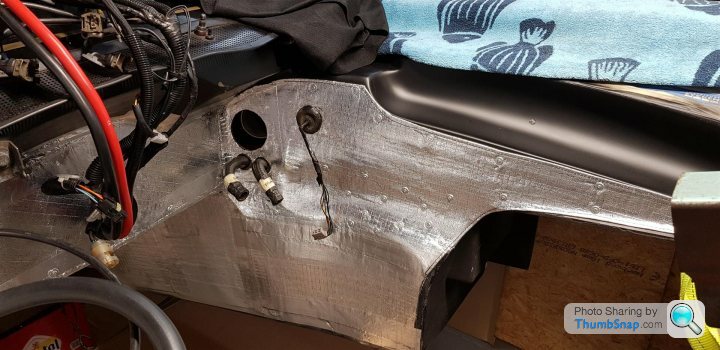
For the other points you mention, I'm not that far yet.
Nice work I should have included a better photo showing the return (negative) cable.
I have made a 50mm² -ve cable to go from the starter motor directly to the battery. (it is a tight fit through the bulk head).
Then from the alternator to the chassis bolt as you described above.
The OLD situation.

As it is now. not the best photo, but this is all I have at the moment.

For the other points you mention, I'm not that far yet.

Edited by FoxTVR430 on Friday 5th April 12:43

The hot start kit masks rather than fixes, it just takes some load off the low amp relay potted inside the immobiliser. This is why its quite common to see Chimaeras with a hot start kit fitted that still exhibit the fault, I have seen many like this.
It fixes nothing, its a sticking plaster solution to the real issue which was that TVR wired the immobiliser incorrectly, the hot start kit may help in the short term or if you're lucky enough to fit it in time before the Meta relay becomes damaged it may work in the long term, but most fit it too late in response to the no cranking issue presenting.
The hot start kit will not and cannot fix the true underlying issue, like fixing anything properly the correct approach to resolving the hot start issue is to first understand the real reason or reasons for the fault in the first place and eliminating them at source.
It fixes nothing, its a sticking plaster solution to the real issue which was that TVR wired the immobiliser incorrectly, the hot start kit may help in the short term or if you're lucky enough to fit it in time before the Meta relay becomes damaged it may work in the long term, but most fit it too late in response to the no cranking issue presenting.
The hot start kit will not and cannot fix the true underlying issue, like fixing anything properly the correct approach to resolving the hot start issue is to first understand the real reason or reasons for the fault in the first place and eliminating them at source.
By replacing your immobiliser you inadvertantly fixed the hot start issue, even if at the time you had no hot start issue your new immobiliser made sure it would never appear.
The new immobiliser was the fix not fitting the hot start kit, so you may as well rip it out as its just a worthless additional point of potential failure.
Heat increases resistance in anything electrical, the weak point in this respect on a Chimaera or Griffith is not the starter motor or its solenoid but the string thin starter cable and the pish poor earth return.
This brings us full circle to the origins of this post.
The new immobiliser was the fix not fitting the hot start kit, so you may as well rip it out as its just a worthless additional point of potential failure.
Heat increases resistance in anything electrical, the weak point in this respect on a Chimaera or Griffith is not the starter motor or its solenoid but the string thin starter cable and the pish poor earth return.
This brings us full circle to the origins of this post.
ed_crouch said:
Crikey, that escalated!!
Thank you, chaps.
One thing: electrons are negative charge carriers therefore they travel around the start cable circuit from the negative to the positive terminals. :P Meeeee? A pedant?!?! Sorry, where's my coat?Ed.
Spot on, as is the advice its best practice to fit a relay in the starter solenoid circuit.Thank you, chaps.
One thing: electrons are negative charge carriers therefore they travel around the start cable circuit from the negative to the positive terminals. :P Meeeee? A pedant?!?! Sorry, where's my coat?Ed.
I cover this in my immobiliser bypass instructions, saying that I when I did this some seven years ago I never bothered to fit one myself and my ignition switch has held up perfectly without a relay.
What I did do however was rip out the pointless hot start kit a previous owner had fitted, it clearly didnt work as I had cranking issues. Using correct diagnostic proceedure and a multimeter I traced the fault to the immobiliser, as soon as I'd bypassed it the car sprang into life.
The starter cable and earth upgrade was the cherry on the cake.
Belle427 said:
Am I right I assuming the circuit the modwise kit was added to is as below, cutting the immobiliser to starter solenoid cable and then adding the relay?
I removed it and added a 40 amp relay and a new 30 amp cable to solenoid but didn't really check out the wiring path.
Ignition switch ------- immobiliser -------- starter solenoid
This is the point, the hot start kit does not bypass the immobiliser so if the relay contacts in the immobiliser are damaged/pitted which they almost certainly will be its not going to help.I removed it and added a 40 amp relay and a new 30 amp cable to solenoid but didn't really check out the wiring path.
Ignition switch ------- immobiliser -------- starter solenoid
There are two relays potted deep inside the Meta unit, one lower amp one intended for the ECU and one higher amp relay intended for the starter solenoid. TVR wired the ECU through the higher amp relay which isnt an issue but wiring the starter solenoid through the lower amp Meta relay most certainly was.
Theres no way on Gods earth the Modwise hot start kit is going to miraculously repair the damage done over the years to that little low amp relay inside the Meta immobiliser caused by TVR running more amps through it than it was designed for.
I suspect the designer of the hot start kit was well meaning when he created it, but because he failed to understand the real reason for the issue he actually inadvertently sold hundreds of false promises to the TVR community who felt reassured by fitting the hot start kit.
Sadly the hot start kit is the worst kind of false promise because it gives owners the belief they've fixed all their starting issues for good, while claiming to solve a problem it actually leaves the true underlying fault very much in place ready to catch the owner out at the most inconvenient moment.
When the Meta relay finally gives out (and eventually it will) the owner with the hot start kit fitted is left completely perplexed as to why his car is failing to start

The hot start kit is fundimentally just a relay, while it is automotive wiring best practice to fit a relay in the starter circuit its purpose is to protect and extend the life of the contacts inside the ignition switch not to privide more amps to the starter solenoid as the designer of the hot start kit will have you believe.
The hot start kit is a badly assembled collection of wires and a micro relay thats actually not really man engough for the job, as such it not only tries to solve a problem it couldn't possibly fix but also introduces another point of failure.
This is why the trusted TVR alarm specialists who understand the real reason for the fault will always remove the hot start kit when they come across it, and I recommend all TVR owners do the same.
Penelope Stopit said:
ChimpOnGas said:
This is the point, the hot start kit does not bypass the immobiliser so if the relay contacts in the immobiliser are damaged/pitted which they almost certainly will be its not going to help.
Dead on ChimpMany people are easily mislead, if an immobiliser relays contacts have been toasted they aren't going to fix themselves, wiring in a relays coil to those contacts is only a temporary fix
The Modwise Hot-Start Kit should be packed in a tin that has temporary fix painted on it
"Does exactly what it says on the tin"
The creator of the kit was well meaning I'm sure, but he clearly failed to identify the true reasons our cars often fail to start and especially when hot. The truth is he inadvertently gave a whole generation of unwitting Chimaera & Griffith owners a false sense of confidence that their starting problems had been resolved while merely introducing another point of failure.
In many ways fitting the hot start kit is actually far worse than leaving things just as they are, because when the immobiliser fault TVR hard wired into every Chim/Griff comes to bite the unsuspecting owner he's left bewildered at the side of the road still convinced he'd previously solved the issue with the Modwise hot start kit

I've sent my imobiliser bypass instructions to literally hundreds of TVR owners who contact me by PM, often they tell me they just cant understand why they have the starting problem as they fitted the hot start kit a few years previously. Sometimes the owner is not confident themselves to complete the bypass so for many owners I've done it for them and nine times out of ten they have the hot start kit installed, I have loads of them in my hall of shame as I always remove the kit.
In all cases the car leaves me starting perfectly where before the owner couldn't trust the engine to start, often I will find other faults that need addressing so I should stress bypassing the immobiliser is not always the solution. But in every single case the hot start kit will be removed and in every single case the car leaves me properly fixed and starting on the button, and no one has ever reinstated their hot start kit because it is most certainly not the magic bullet solution it claims to be!
The cable gauge used by TVR was marginal at best, especially for its considerable 7ft length, TVR then draped it over the bell housing trapping it behind the hot cylinder heads & exhaust manifolds where there's also little or no air flow to cool it.
During its life the cable gets heated up and cools down literally hundreds if not thousands of times, add all this to the fact it's now probably 20 plus years old & heavy internal corrosion will be the consequence which will significantly increase resistance.
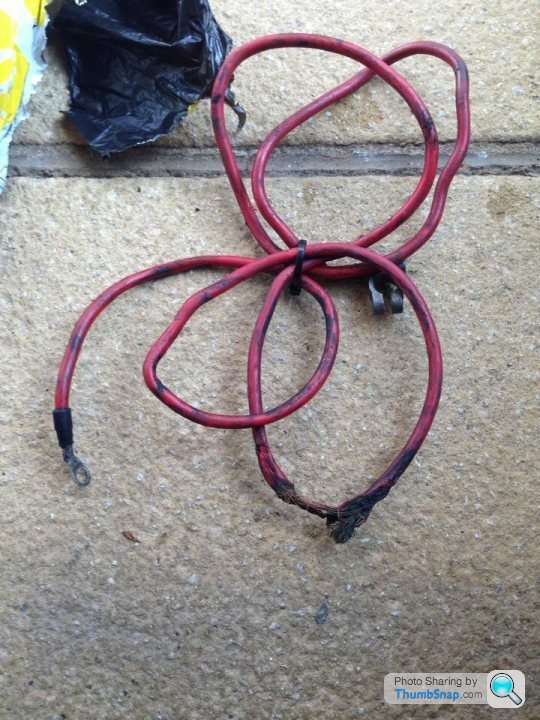
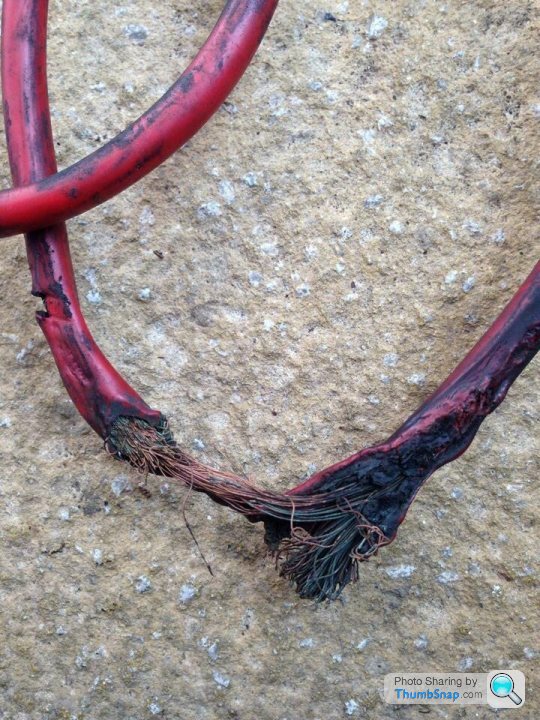
Definitely worth replacing, not only to improve cranking but as the above clearly demonstrates.... to reduce risk of fire too!
On the subject of the immobiliser, TVR definitely wired it incorrectly for a number of years throughout the 1990's, this is well accepted fact, I have spoken to a number of respected TVR alarm specialist who have all confirmed this. Carl Baker who was (and probably still is) the go TVR alarm specialist having fitted literally hundreds of correctly wired Meta systems to TVRs explained to me Meta themselves knew about TVR's mistake in period.
Carl explained throughout the 1990's Meta knew about the mistake TVR was making, they sent many memos to TVR to try to correct the error of their ways but apparently these memos were all ignored. Carl Baker was Meta factory trained and has kept a close relationship with the company for many years, the mistake made by TVR is not a story it is fact and indeed born out by what I found myself. If people still remain unconvinced I recommend calling Carl himself or David from HF Solutions, alternatively have a read of the Abacus Alarms website that explains TVR's mistake in detail half way down this page:
https://www.abacuscaralarms.co.uk/tvr-alarms.html
Finally here's a snapshot from the Meta M36 installation manual that TVR clearly failed to read properly:
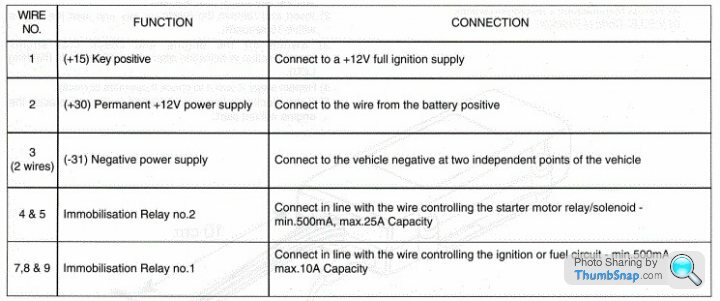
Relay number 2 is rated at 25a, as per their above instructions Meta intended this for the far higher amp starter motor solenoid circuit, relay number 1 on the other hand was far lower rated at 10a. TVR's decision to ignore Meta's clear instructions and subsequent memos meant they consistently wired the starter solenoid through this 10a relay throughout the 1990's and with inevitable consequences.
An engineer is someone who studies the system, understands how it was designed to work, identifies the fault and corrects it.....a fool is someone who refuses to accept the facts.
During its life the cable gets heated up and cools down literally hundreds if not thousands of times, add all this to the fact it's now probably 20 plus years old & heavy internal corrosion will be the consequence which will significantly increase resistance.


Definitely worth replacing, not only to improve cranking but as the above clearly demonstrates.... to reduce risk of fire too!
On the subject of the immobiliser, TVR definitely wired it incorrectly for a number of years throughout the 1990's, this is well accepted fact, I have spoken to a number of respected TVR alarm specialist who have all confirmed this. Carl Baker who was (and probably still is) the go TVR alarm specialist having fitted literally hundreds of correctly wired Meta systems to TVRs explained to me Meta themselves knew about TVR's mistake in period.
Carl explained throughout the 1990's Meta knew about the mistake TVR was making, they sent many memos to TVR to try to correct the error of their ways but apparently these memos were all ignored. Carl Baker was Meta factory trained and has kept a close relationship with the company for many years, the mistake made by TVR is not a story it is fact and indeed born out by what I found myself. If people still remain unconvinced I recommend calling Carl himself or David from HF Solutions, alternatively have a read of the Abacus Alarms website that explains TVR's mistake in detail half way down this page:
https://www.abacuscaralarms.co.uk/tvr-alarms.html
Finally here's a snapshot from the Meta M36 installation manual that TVR clearly failed to read properly:

Relay number 2 is rated at 25a, as per their above instructions Meta intended this for the far higher amp starter motor solenoid circuit, relay number 1 on the other hand was far lower rated at 10a. TVR's decision to ignore Meta's clear instructions and subsequent memos meant they consistently wired the starter solenoid through this 10a relay throughout the 1990's and with inevitable consequences.
An engineer is someone who studies the system, understands how it was designed to work, identifies the fault and corrects it.....a fool is someone who refuses to accept the facts.
Loubaruch said:
TVR are reputed to have incorrectly wired the immobiliser using the low current relay for the starter etc.
That is certainly not the case for all cars. My 1996 Griffith was wired correctly but I installed a relay in the starter immobiliser circuit as good practice. To say the "Hot start Kit" is superfluous is a nonsense as it is just effectively a relay to protect the immobiliser contacts. With correctly rated immobiliser contacts it is probably overkill but does give peace of mind.
IMHO there is quite a lot of questionable advice given on here regarding TVR's electrical wiring. For example using grossly over rated cables for the battery and earth leads. With connections clean and efficient there is no need to install what are effectively Bus Bars for the starter circuit etc. Of course they will work but are they necessary? In my opinion NO.
My 22 year old car owned for 15 years has never ever had a starter problem on the original wiring.
An Engineer is someone who can make something work efficiently for 50p where any bloody fool can make it work for a £1!
TVR already gave us this mess...That is certainly not the case for all cars. My 1996 Griffith was wired correctly but I installed a relay in the starter immobiliser circuit as good practice. To say the "Hot start Kit" is superfluous is a nonsense as it is just effectively a relay to protect the immobiliser contacts. With correctly rated immobiliser contacts it is probably overkill but does give peace of mind.
IMHO there is quite a lot of questionable advice given on here regarding TVR's electrical wiring. For example using grossly over rated cables for the battery and earth leads. With connections clean and efficient there is no need to install what are effectively Bus Bars for the starter circuit etc. Of course they will work but are they necessary? In my opinion NO.
My 22 year old car owned for 15 years has never ever had a starter problem on the original wiring.
An Engineer is someone who can make something work efficiently for 50p where any bloody fool can make it work for a £1!
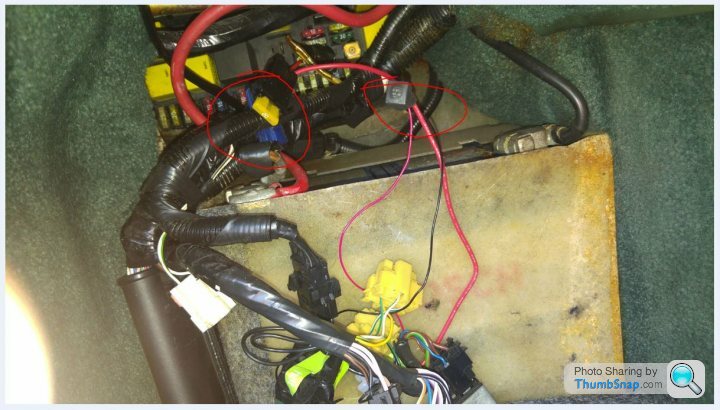
Then people added this mess on top, which is sold for a lot more than £1.00 BTW
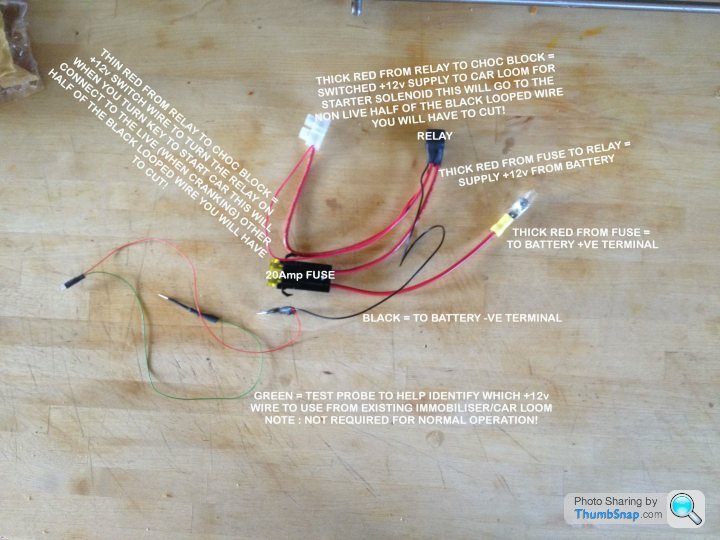
The hot start kit really is a completely unnecessary amateurish made collection of wires, crimp, and choc block connector with a tiny little difficult to source little relay thrown in for good measure.
AVOID!
Precisely chaps, as soon as people accept the fact that TVRs wiring was not the best they can move on to improving it.
The error TVR made when wiring the Meta immobiliser in the 90'S is well documented accepted fact, speak with any of the three TVR alarm gurus mentioned in my above post and they will confirm this, or just read what Abacus Alarms have to say on the subject on their website (see link above).
TVRs are fantastic unique cars, I have remained passionate about mine throughout the ten years I've owned it but I'm under no illusions it could have been built better and the poor wiring is a key case in point.
We all love our TVRs but denial and rose tinted specs get you nowhere.
The error TVR made when wiring the Meta immobiliser in the 90'S is well documented accepted fact, speak with any of the three TVR alarm gurus mentioned in my above post and they will confirm this, or just read what Abacus Alarms have to say on the subject on their website (see link above).
TVRs are fantastic unique cars, I have remained passionate about mine throughout the ten years I've owned it but I'm under no illusions it could have been built better and the poor wiring is a key case in point.
We all love our TVRs but denial and rose tinted specs get you nowhere.
I started this post on the 17th January 2012, my starter cable upgrade made a massive improvement to the way the car cranked and started but to get the full effect my work didn't just end with that one cable.
For example here's my direct from battery negative terminal to engine earth where I secured the thick marine tinned 35mm2 cable to a stout inlet manifold bolt.
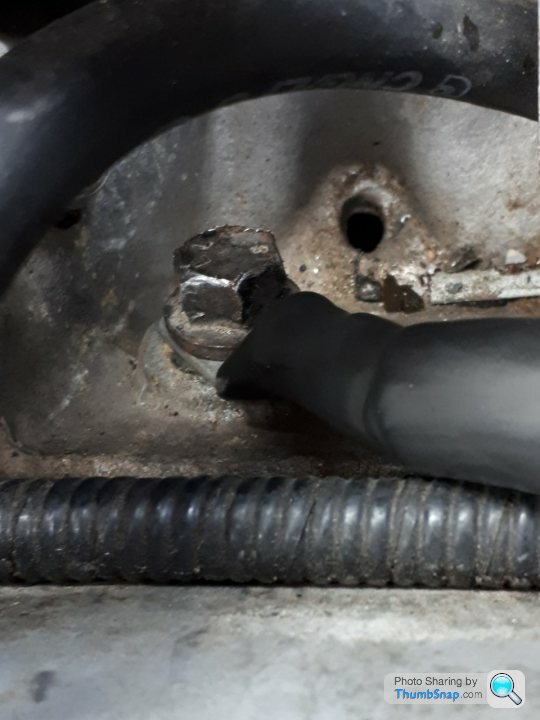
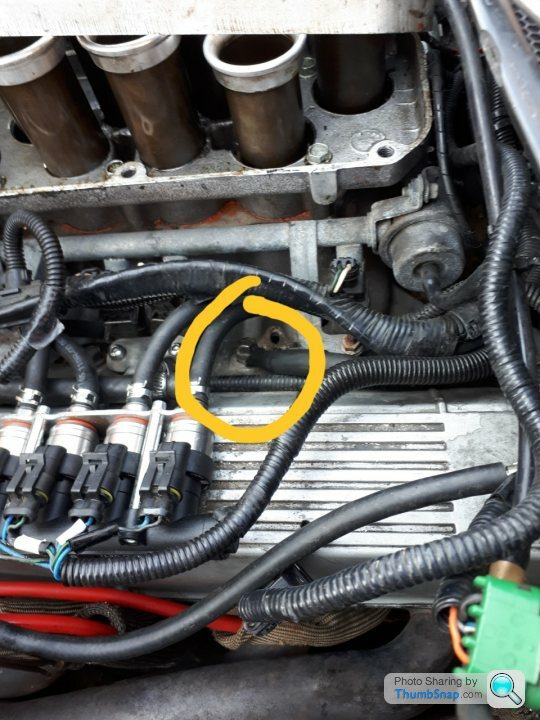
I also found and corrected this mess recently...

It's the main alternator output cable which TVR wrapped up in a nice EMI inducing bundle of engine bay wires....
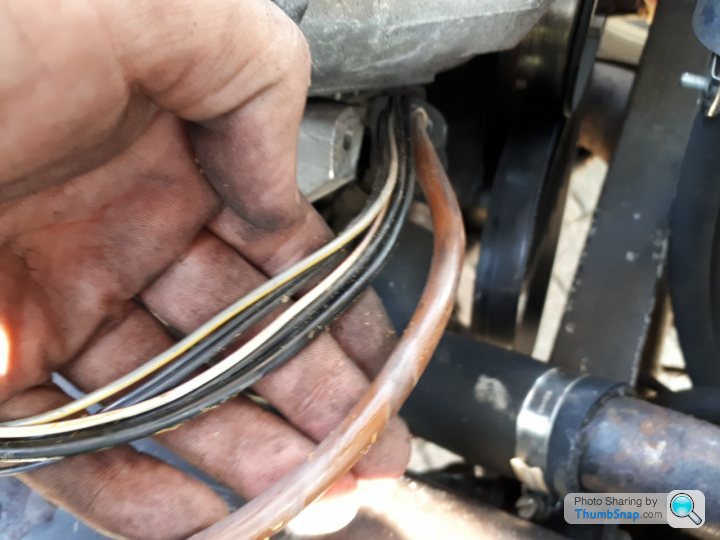
The above five wires had been literately wound around the charge cable like a vine to create a nice electrical coil
I completed the job by replacing the charge cable with something new and beefier, then gave those five wires a new path away from my new heavier charge cable.

Check out the old TVR (brown) cable with the new one I fitted.

The chassis outrigger stud and the main engine earth cable looked a bit ropey too.

So I made up a new block to chassis earth.
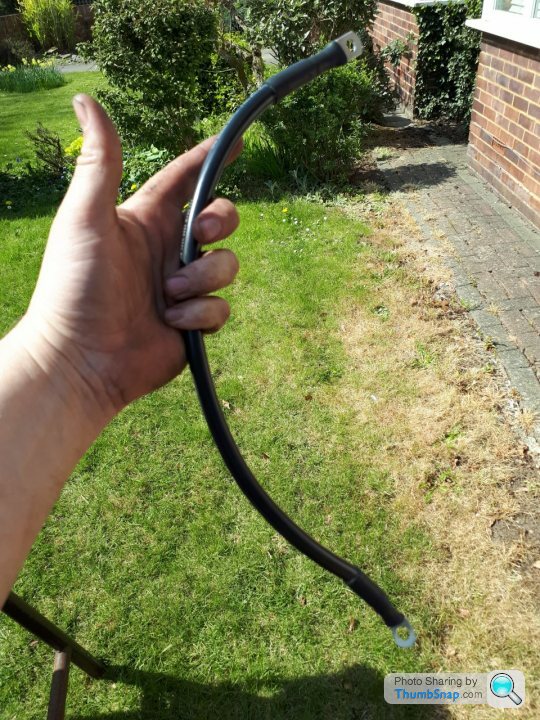
I left the old one in place with my oil pressure sender earth, cleaned up the ring connectors and the stud itself then added my new beefier engine block to chassis earth cable.
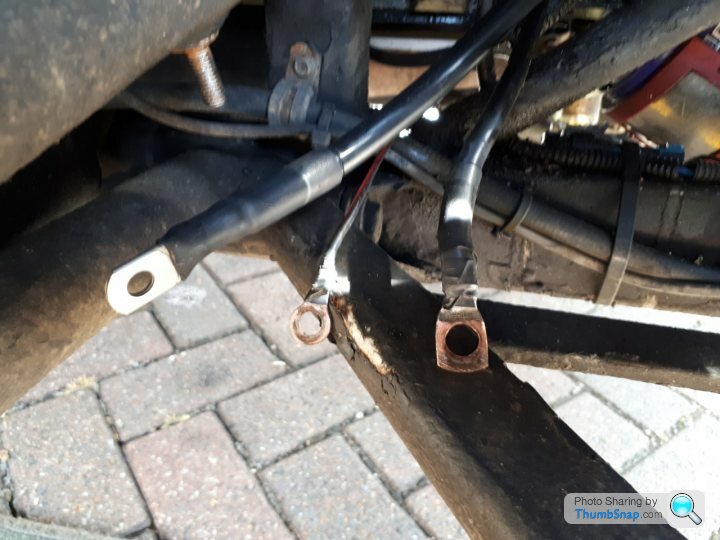
And finally finished by connecting the other end of my new beefier engine block to chassis earth cable to a stout bolt that secures my JE alternator bracket to the O/S cylinder head which is nice and close to my Denso/Marrelli 120amp alternator to give its rectifier an easier life.
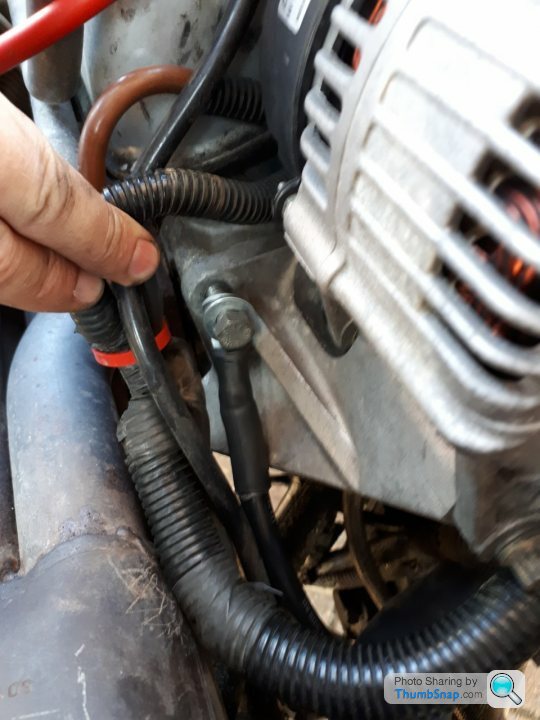
I've got to say my hydraulic crimping tool has proved an invaluable purchase, some quality tube connectors and proper glue lined heat shrink complete the recipe for perfect connectors.

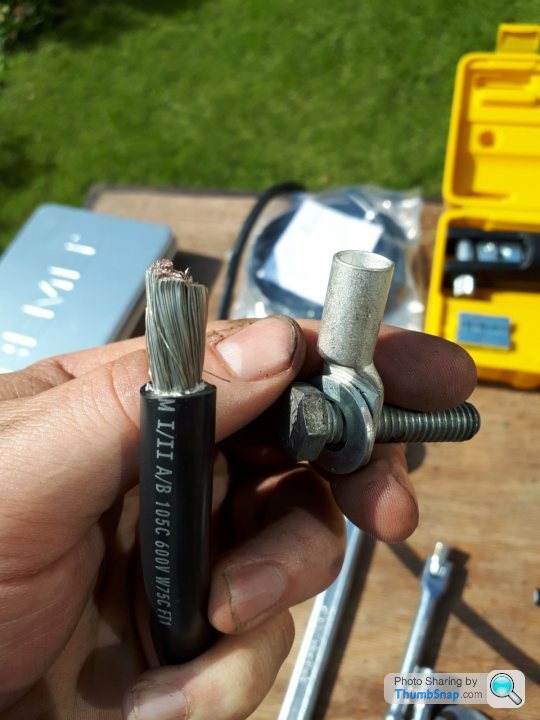
Just that pesky corrosion prone front chassis earth point to go which I'm certain will need a good clean up but I need to whip the rad out to do that properly so I'll have a go at it in a few weeks.
For example here's my direct from battery negative terminal to engine earth where I secured the thick marine tinned 35mm2 cable to a stout inlet manifold bolt.


I also found and corrected this mess recently...

It's the main alternator output cable which TVR wrapped up in a nice EMI inducing bundle of engine bay wires....

The above five wires had been literately wound around the charge cable like a vine to create a nice electrical coil

I completed the job by replacing the charge cable with something new and beefier, then gave those five wires a new path away from my new heavier charge cable.

Check out the old TVR (brown) cable with the new one I fitted.

The chassis outrigger stud and the main engine earth cable looked a bit ropey too.

So I made up a new block to chassis earth.

I left the old one in place with my oil pressure sender earth, cleaned up the ring connectors and the stud itself then added my new beefier engine block to chassis earth cable.

And finally finished by connecting the other end of my new beefier engine block to chassis earth cable to a stout bolt that secures my JE alternator bracket to the O/S cylinder head which is nice and close to my Denso/Marrelli 120amp alternator to give its rectifier an easier life.

I've got to say my hydraulic crimping tool has proved an invaluable purchase, some quality tube connectors and proper glue lined heat shrink complete the recipe for perfect connectors.


Just that pesky corrosion prone front chassis earth point to go which I'm certain will need a good clean up but I need to whip the rad out to do that properly so I'll have a go at it in a few weeks.
phillpot said:
ChimpOnGas said:
Check out the old TVR (brown) cable with the new one I fitted.
Just how many Amps can your alternator generate? 
When replacing cables there is no harm in going larger, but there are certainly disadvantages running a 22 year old internally corroded cable. So lets say I decide to replace my old cable thats had its day (which is a good idea), there is absolutely no harm whatsoever is using the cable stock I have on the shelf..... even if it is 35mm2.
Does that answer your question?
Gassing Station | Chimaera | Top of Page | What's New | My Stuff







